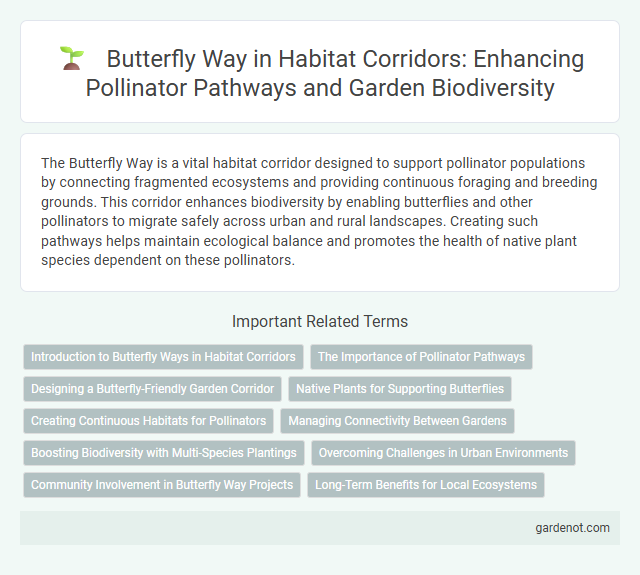The Butterfly Way is a vital habitat corridor designed to support pollinator populations by connecting fragmented ecosystems and providing continuous foraging and breeding grounds. This corridor enhances biodiversity by enabling butterflies and other pollinators to migrate safely across urban and rural landscapes. Creating such pathways helps maintain ecological balance and promotes the health of native plant species dependent on these pollinators.
Introduction to Butterfly Ways in Habitat Corridors
Butterfly Ways are specialized habitat corridors designed to facilitate the movement and migration of butterfly species across fragmented landscapes. These corridors incorporate native nectar plants and host plants that support the complete life cycle of butterflies, enhancing biodiversity and ecosystem connectivity. By improving habitat quality and reducing barriers, Butterfly Ways contribute significantly to conservation efforts and pollination services.
The Importance of Pollinator Pathways
Butterfly way habitat corridors are crucial pollinator pathways that enhance biodiversity by connecting fragmented ecosystems, allowing butterflies and other pollinators to safely travel and access diverse floral resources. These corridors support essential ecosystem services such as pollination, which boosts crop yields and maintains healthy plant populations. Protecting and restoring pollinator pathways helps counteract habitat loss and climate change impacts, sustaining ecological balance and food security.
Designing a Butterfly-Friendly Garden Corridor
Creating a Butterfly-Friendly Garden Corridor involves planting native flowering plants that provide nectar and host plants essential for butterfly life cycles, such as milkweed for monarchs. Incorporating continuous strips of diverse vegetation ensures safe passage and feeding opportunities, enhancing butterfly migration and reproduction. Strategic placement of shelter zones and water sources within the corridor increases habitat connectivity and supports butterfly population sustainability.
Native Plants for Supporting Butterflies
Native plants such as milkweed, coneflowers, and goldenrod provide essential nectar and host resources for butterflies in habitat corridors, ensuring their survival and reproduction. These plants support diverse butterfly species by offering food sources throughout different life stages, including larval host plants and adult nectar sources. Incorporating a variety of native flowering plants enhances pollinator pathways, promoting biodiversity and ecological resilience in butterfly way corridors.
Creating Continuous Habitats for Pollinators
Butterfly Way establishes continuous habitats by connecting isolated patches of native plants, ensuring essential nectar sources and breeding grounds for pollinators. This corridor enhances pollinator movement and genetic diversity, crucial for species resilience and ecosystem health. Strategic planting along Butterfly Way supports key pollinator species like monarch butterflies, bees, and hummingbirds, promoting sustainable biodiversity.
Managing Connectivity Between Gardens
Butterfly Way promotes managing connectivity between gardens by creating continuous habitat corridors that support butterfly migration and breeding. Strategic planting of native nectar and host plants ensures resource availability across fragmented urban landscapes. This interconnected network enhances biodiversity, strengthens pollination ecosystems, and mitigates habitat isolation effects.
Boosting Biodiversity with Multi-Species Plantings
Butterfly Way habitat corridors enhance biodiversity by integrating multi-species plantings that support diverse butterfly populations and other pollinators. These corridors create continuous, nutrient-rich habitats that promote species interaction, genetic diversity, and ecosystem resilience. Strategic selection of native flowering plants and host species strengthens food webs essential for sustaining butterfly life cycles and overall environmental health.
Overcoming Challenges in Urban Environments
Butterfly Way habitat corridors address critical challenges in urban environments by creating connected green spaces that facilitate butterfly migration and reproduction despite habitat fragmentation. These corridors incorporate native flowering plants and pollen sources, improving urban biodiversity and supporting pollinator health. Implementing sustainable urban planning strategies that integrate Butterfly Way corridors helps mitigate the negative impacts of urban sprawl on butterfly populations and ecosystem services.
Community Involvement in Butterfly Way Projects
Community involvement in Butterfly Way projects strengthens habitat corridors by fostering local stewardship and biodiversity awareness. Volunteers collaborate on planting native wildflowers and creating safe passages, which enhance pollinator networks essential for ecological balance. Educational workshops engage residents, promoting sustainable practices that support butterfly populations and regional connectivity.
Long-Term Benefits for Local Ecosystems
Butterfly way habitat corridors enhance biodiversity by connecting fragmented landscapes, enabling pollinators like butterflies to thrive and support plant reproduction. These corridors promote genetic diversity and resilience in local ecosystems, helping to stabilize food webs and improve ecosystem services such as soil health and water purification. Over time, the increased habitat connectivity boosts ecosystem productivity and strengthens natural habitats against environmental stressors.
Butterfly way Infographic

 gardenot.com
gardenot.com